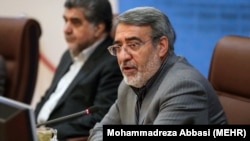Disregarding comments made by the supreme leader and his allies on the role of “the enemy” and “exiled dissidents” in the recent uprising in Iran, Interior Minister Abdolreza Rahmani Fazli has admitted the protests were not organized or provoked by outsiders.
Fazli says that “field studies” have shown the protests were not organized by forces outside Iran.
“This does not mean that dissidents and anti-Islamic Republic opposition did not take advantage of the protests and intensify them for their own ends,” he told the government-run daily newspaper Iran. “As a matter of fact, they used their utmost capability to stoke the fires and gain from the unrest.”
As soon as the uprising broke out on December 28, 2017, in the city of Mashhad and spread to more than 100 other cities across Iran, allies of Supreme Leader Ayatollah Ali Khamenei, including the prosecutor-general and other conservatives, accused the C.I.A. of directing the protests in cooperation with elements close to former Iraqi dictator Saddam Hussain and the Mujahedin Khalq Organization (MKO).
Khamenei claimed on January 9 that the protests were organized and financed from abroad and that Tehran had foiled attempts by its “enemies” to overthrow the current regime.
Khamenei had described the protests voicing anger over corruption, poverty, and tyranny as a “foreign enemy’s counterattack,” financed by a “stinking-rich government” in the region, an obvious reference to Saudi Arabia.
Khamenei insisted the protesters were expressing dissatisfaction with corruption, not the Islamic Revolution or the system of government itself.
However, during the demonstrations – especially those in the two holy Shi’ite cities of Qom and Mashhad -- angry participants chanted slogans in support of Iran’s last royal dynasty, Pahlavi, and explicitly against the ruling system and its leaders.
Furthermore, the protesters demanded an end to the clergy-controlled system in Iran, shouting slogans against the two factions -- reformist and conservative -- that have ruled Iran for nearly four decades. “Reformists, conservatives, the end is nigh,” they chanted.
While Khamenei and hardliners, including the Islamic Revolutionary Guard Corps (IRGC), insist that foreigners were behind the protests, President Hassan Rouhani and some of his reformist supporters maintain that this is an insult to Iranian people.
Khamenei’s statements on Twitter and via Iranian media sharpened the contrast between his position and that of Rouhani on the real causes of the protests, which shook the country for more than 10 days.
Demonstrators were said to be mainly between the ages of 16 and 25, frustrated with a lack of jobs, rising prices and lack of social and political freedom. Their slogans turned increasingly more rejectionist, calling for systemic changes to the regime.
But the supreme leader’s position ascribed the unrest mainly to foreign machinations.
"Once again, the nation tells the U.S., Britain, and those who seek to overthrow the Islamic Republic of Iran from abroad that they’ve failed, and they will fail in the future, too," Khamenei tweeted.
However, Khamenei acknowledged in his latest messages that people might have real grievances.
"These concerns must be addressed. We must listen, we must hear. We must provide answers within our means," Khamenei was quoted as saying, hinting that not only the government of Rouhani but his own clerical leadership must also respond.
Meanwhile, the interior minister believes that the real reason behind protests in Iran and its swift spread all over the country is the “accumulation of dissatisfaction” among people, in a way that it could re-emerge at any given time.
Fazli also maintained that Rouhani’s administration has started a series of negotiations with different political, labor, media, and students’ rights groups to prevent further unrest.




